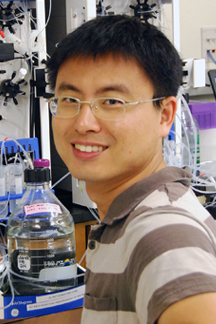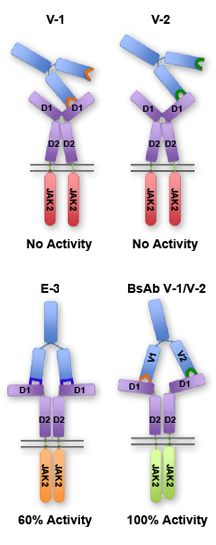Scientists Devise Powerful New Method for Finding Therapeutic Antibodies
Scientists at The Scripps Research Institute have found a new technique that should greatly speed the discovery of medically and scientifically useful antibodies, immune system proteins that detect and destroy invaders such as bacteria and viruses. New methods to discover antibodies are important because antibodies make up the fastest growing sector of human therapeutics; it is estimated that by 2014 the top-three selling drugs worldwide will be antibodies.
The new technique, described in an article this week published online ahead of print by the journal Proceedings of the National Academy of Sciences, enables researchers to search large libraries of antibodies and quickly select the ones with a desired biological effect. It also provides for the creation of unusual, asymmetric antibodies whose capabilities extend beyond those of natural antibodies. The Scripps Research scientists demonstrated the power of the technique by using it to find an asymmetric antibody that almost perfectly mimics the activity of erythropoietin (EPO), a medically valuable hormone.
“Traditionally we’ve looked at antibodies as tools for binding to specific targets, but we should view them more generally, as tools for probing and altering functions in cells,” said Richard Lerner, the Lita Annenberg Hazen Professor of Immunochemistry and member of the Department of Molecular Biology at Scripps Research who led the new study.
At the Vanguard
Lab-grown antibodies already represent a major part of the ongoing biotechnology revolution. Used as scientific probes or medical therapies, they recreate the versatility of natural antibodies, which are produced by immune cells in a vast diversity to bind to highly specific shapes on viruses, bacteria, and other targets.
Two decades ago, Lerner and his laboratory at Scripps Research, in parallel with the group of Sir Gregory Winter at the Laboratory of Molecular Biology in Britain, developed the first techniques for generating very large libraries of combinatorial antibodies and quickly isolating those that can bind to a desired target. Since then, such techniques have been used to find antibodies to treat cancer, arthritis, transplant rejection, and other conditions. Humira, an anti-inflammatory antibody that was discovered this way, is expected to be the world’s top-selling drug this year. Belimumab (Benlysta®) was approved by the US Food and Drug Administration in 2011 to treat lupus, becoming the first new drug to treat the chronic, life-threatening inflammatory disease in more than 50 years.
Current antibody-discovery techniques have one big drawback, however. Although they can rapidly find antibodies that bind tightly to a known target, they can’t rapidly determine which of those antibodies has useful biological activity. An antibody may bind tightly to a virus without affecting the virus’s ability to infect cells, for example, or it may bind to a cellular receptor without activating that receptor. With current techniques, determining the overall biological effect of a target-binding antibody typically requires further, painstaking analysis.
A More Direct Path
In the new study, Lerner and his postdoctoral researcher Hongkai Zhang sought a method for rapidly finding antibodies that have a desired effect on cells, not just a desired ability to bind to a target. As a proof of principle, they aimed to discover an antibody that could mimic the activity of EPO, a hormone that stimulates red blood cell production. Drugs that mimic EPO’s effect are commonly used to treat anemia and related conditions.
Zhang began by using traditional techniques to quickly sift through a large antibody library to find tens of thousands of antibodies that bind tightly to the EPO receptor. He then stepped beyond traditional techniques, by taking the genes that encoded these EPO-receptor-binding antibodies and inserting them into lentiviruses. Unlike the phage viruses used in traditional methods, lentiviruses can usefully infect mammalian cells, delivering their payloads – antibodies, in this case – into a more human-like cellular environment.
Zhang applied this new library of antibody-coding lentiviruses to a single, large culture of mammalian test cells. The cells were of a type that express EPO receptors and proliferate when these receptors are bound by EPO proteins – or by antibodies that effectively mimic EPO. Each of these cells could host only a few viral particles at most, so in this way Zhang was able to distribute the entire library of EPO-receptor-binding antibodies broadly within the cell culture. Zhang also cultured the cells in a special way that prevented antibodies secreted by one cell from spreading easily to nearby cells and muddying any cause-effect relationship. “This concern over the diffusion of antibodies in the culture was one of the factors that had discouraged other researchers from using such a technique,” said Zhang.
After the lentiviruses had delivered the antibodies to the cultured cells, Zhang was able to note which cells were proliferating the most – signifying the presence of antibodies that mimic EPO. To identify the antibodies responsible, Zhang had only to harvest these faster-growing cells and sequence the antibody genes inside them.
This method quickly yielded an antibody that in a further test showed about 60 percent of the biological activity of natural EPO – which was as good as any antibody EPO-mimic that had ever been described.
Opening the Door to the Unknown
But Zhang and Lerner also noted that many of the proliferating cells had been infected by multiple lentivirus particles, and contained sequences from more than one antibody. Puzzlingly, Zhang found that when he recreated antibodies from these sequences, and tested them individually or in combinations, they showed no significant EPO-mimicking effect. Further tests showed that the source of the EPO-mimicking effect in the test cells was an antibody that does not occur naturally.
An antibody of the type used in the study has a Y-shaped structure, normally with two identical binding arms. But the presence of multiple antibody genes within some of Zhang’s test cells meant that, in a few cases, antibodies assembled themselves with two different binding arms. One of these “bispecific” antibodies turned out to bind to the EPO receptor – which has two binding sites – in a way that very accurately mimics the binding of a natural EPO molecule. “It turned out to be 100 percent as potent as authentic EPO in further tests,” Zhang said.
The serendipitous finding represents another major innovation, for, in principle, it extends the medical and scientific antibody repertoire from the 100 billion or so known variants of same-armed antibodies to an astronomically higher number of bispecific variants. Experiments to test such variants will be limited by the maximum number of usable cells in cultures, but that number is still very high, on the order of 10 million. “That allows for a lot of unique binding events,” said Lerner. “You probably can get almost anything that way.”
Lerner emphasizes that this new antibody-engineering/discovery technique can be used not just against known targets such as the EPO receptor, but also against cellular functions involving targets that have not yet been found. “The real power of this technique is its ability to help us discover the unknown,” he said.
Another author of the study, titled “Selection of antibodies that regulate phenotype from intracellular combinatorial antibody libraries,” was Ian A. Wilson, the Hansen Professor of Structural Biology at Scripps Research and an expert on the structure of the EPO receptor. For more information on the paper, see http://www.pnas.org/content/early/2012/09/05/1214275109.abstract
Send comments to: press[at]scripps.edu
















